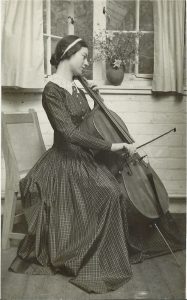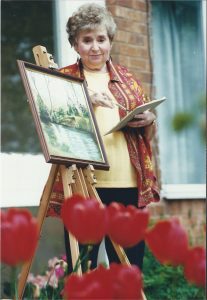What does multiple sclerosis and the cello have in common for me? Quite a lot actually, though maybe indirectly.
I began thinking – putting this and that together – last week, after seeing The Cellist, a new work by Cathy Marston, based on the life of Jacqueline du Pre, for the Royal Ballet. It was streamed live from the Royal Opera House, and I had driven to Aberfeldy’s community cinema The Birks, to see it especially. (In rehearsal: https://www.youtube.com/watch?v=F6DS-SOVGiI&t=12s)
Why? Because my mother, Gwendoline Loader (nee Price), played the cello, and very well I have been told. She learned in Birmingham, to which she had moved from Wales to study fashion illustration at Birmingham Art School in the late 1920s. A few years later she joined the Rudolf Steiner community at Sunfield, a pioneering residential home for children with special needs, at Clent Grove, near Bromsgrove. It was here that her love for the cello was born. (Me too!)

My mother took me to Sunfield for my seventh birthday. I remember walking through long corridors of sweet-smelling wooden wardrobes containing rainbows of silk clothing (much of which she has sewn during her seven year stay) for performances of Eurythmy.

My mother, wearing the taffeta dress she made for professional appearances. Because Michael Wilson – the founder of Sunfield (and my godfather) – was set on creating an orchestra, she and other musically-inclined souls were sent from Sunfield to Birmingham to study cello with the conductor Johan Hoch. Her comrades swiftly hit the dust but Hoch kept my mother on, in large part because of what Michael described as “a good bowing arm”.Travelling to Birmingham, she regularly played with its municipal symphony orchestra. The city’s philharmonic was not founded until 1941, and by that time she was busy with me.

Hilly sent me this just the other day. David and my mother were enabled to reconnect in later years, and died within a week of one another, in 2007.
At Sunfield, she created music with any number of professional instrumentalists, many of whom were Jewish refugees from Germany, but including her dear friend David Clement, a biodynamic farmer who also played the cello. They played together in recitals, to accompany Eurythmy and any number of other theatre and dance productions.
*Eurythmy is an expressive movement art originated by Rudolf Steiner in conjunction with Marie von Sivers in the early 20th century. Primarily a performance art, it is also used in education, especially in Waldorf schools, and – as part of anthroposophic medicine – for claimed therapeutic purposes. The word eurythmy stems from Greek roots meaning beautiful or harmonious rhythm. (Wikipedia) *
David’s cousin, Hilly Clement, and I are in constant touch, because she has been archiving materials relating to Sunfield’s early days in the 1930s, and in searching through my mother’s papers and photographs, I have found numerous items of great interest, now passed on. Only last week, she mailed a photo that her daughter had scanned for me; this week I must send the recent photo I just found showing all staff and children standing in front of the main building, my mother included. Things keep turning up all the time…
Nowadays I find myself wondering why my mother laid her cello aside once she was married and had me and my sister Bridget Bateman (nee Loader). I remember there was a piano in the front room in Coventry that she played sometimes, and tried – unsuccessfully – to get us to study. I have no memory at all though, of where the cello was kept.
All I do know is that after her removal to a care home in 2005, we found it in a cupboard here, pretty much in pieces. I was still living in Japan, so when Bridget took it to Coventry for repair, felt only relief. But then the following year she told me she had given it away, to the city’s youth orchestra, and while acknowledging this as ‘a good thing to do’, found myself increasingly upset not to have been consulted.
Just a few months after our mother died in July 2007, Bridget chose (on some subconscious level) to join her. At which point, enquiries were made as to the cello’s fate, only to learn that due to a surfeit of string instruments, it was stored away, stored in yet another cupboard, and had never been played. And so it came home…
Soon after moving here from Japan, I found a teacher in Grantully who was prepared to help me get started. But after only a few lessons, I had to admit defeat. The pinkie of my left hand had been dislocated as a nine-year-old – bashed by a boy in the school playground – and in stretching to reach and cover the strings, it swelled and became arthritic. I had left it too late.
So here it stands, in prime condition and much admired. At least eighty years old, but with its original provenance sadly lost. In being repaired, not only did its bow go missing – nicked we reckoned, as a beauty and valuable – but any paperwork inside the cello, was removed and never replaced. So now I have no idea where it was made, or by whom.
I fell I love with the cello, not because I had grown up hearing my mother play, but listening to Jacqueline du Pre on the radio. I loved not only the rich and evocative sounds she created, but her youthful energy and passionate love of her instrument. To say that it was a tragedy to be cut off in her prime by MS (multiple sclerosis) is an understatement. Thankfully we have sound recordings and even film clips to keep us in touch with of her joyous gift.
To see on YouTube her playing the first movement of Elgar’s Cello Concerto, conducted by her then husband Daniel Barenboim, takes me back to the days when we had only sound at our fingertips. (Charismatic, free, in love with life: (https://www.youtube.com/watch?v=OH0jUQTCCQI)

My mother is at the foot of the drape on the right, wearing white. Was this in Birmingham? On the back of the photograph is printed: A.H.LEALND, Photographer, Fleet Chambers, 5 Fleet Street, Coventry Phone 4392 Reference No. 340. So a bit of a mystery as to where or when.
To more recently see this life choreographed onstage, takes me back to the days when I studied Martha Graham’s dance form (called Laban, but nowadays referred to as Graham Technique) leaping and stretching as lightly and flexibly as did the members of the Royal Ballet: the girls lifted and swirling like feathers, the boys leaping with jock-strapped alacrity. Interesting to see – for the first time? – female principal dancer (Lauren Cutherbertson) ‘manipulating’ the male dancer (Marcelinno Sambe). In classical ballet the male supports the female; in this case J.de.Pre supported the male dancer dancing the role of her beloved cello.
Interesting also to see Barenboim not being allowed to get away lightly with his disloyalty to his wife once she became ill and no longer fed ambition and ego. It reminded me of how Bridget’s husband, Geoffrey, also cleared off once her own rheumatoid arthritis began to impinge upon and affect his own life.

Falling on ice on ice when she was 16, Bridie hurt her knees which swelled and failed to recover. Rheumatoid arthritis was diagnosed and she spent much of her life in and out of hospital having joints replaced. No that it stopped her doing anything – singing, volunteering with Arthritis Care, painting… But the toll on her body was too much, and at age 64, after an elbow operation that failed to heal, she died of sepsis. Her courage was exceptional, as the 250 people who attended her funeral in September 2007 bore witness.
The same cannot be said of Richard Darbourne, my cousin Genevieve’s partner, who stayed with her until the very end in January 2017. An excellent man, also a writer, and with whom I remain in contact.
Gen and I were lost to one another for many years. Her mother, Betty Elwell (nee Loader) – my father’s youngest sister – had died in childbirth, so explaining why her second daughter was christened in her name: Elizabeth. Their father, John, bereft and lost, soon remarried, and his new wife wanted nothing to do with Betty’s family.
I knew I had these two first cousins, but there was never any contact and I had no idea where they were. Until 1999, that is, when I decided to try and find Gen. I was preparing for a journey into ancestral roots in South America, and wondered if she would be interested. I found her very quickly, in fact, and she too was thrilled to be reconnected, mailing a photo to Chile that I could add to all the others I was leaving in our grandfather’s grave in Uruguay. (Read Chasing Shooting Stars, 2013, for the full story.)

Towards the end we would walk with her to have coffee and watch the world go by, times she relished with great courage and good humour.

Richard, Gen and Akii. Happy but bitter-sweet times…
Visiting her in South London on my return, I found her chair-bound with MS. She had told me of her situation, but still it was a shock. Even more shocking to hear that Elizabeth had also suffered the condition, but in a different form. On her way to being a professional violinist, Liz had woken one morning to find her bowing arm strangely unfeeling… and that was the end of any career in music. She died in the 1990s, but not of MS, but breast cancer.
I have vivid memories of when Gen was well enough to scoot up and down Bromley’s Hilly Fields in her wheelchair, us chasing after. Akii and I also met up with her younger son Jonny in Japan, where he was travelling with a visiting UK youth orchestra; he plays the viola and has an exceptional tenor voice, so continuing the musical tradition in the family. Genevieve’s funeral was beautiful and extraordinarily supportive for all who attended, with largely anthroposophically-inclined words, secular music, and standing room only.
Looking back to family folklore, I wonder if Barney – my father’s younger brother – also had MS. The story was that having stood in the sea for two days at Dunkirk, waiting to be rescued, his legs had never been the same again. Again, there was little to no contact and now I shall never know.

My father, Samuel Robert (Bob) Loader, with his two younger siblings, Barney and Betty, in Liverpool in the 1920s.
I am the only immediate survivor of my family on both sides, the Loaders and the Prices, and I cannot help wondering why they have been so beset with physical and mental problems. An exceptionally heavy karmic burden… I am next in line, which I suspect is one reason why it’s so important to me to record what I can while I can. To help continue trying to make sense of it all, and maybe – maybe – help reduce that oppressively heavy load next time around.
This is why I made the journey to South America in 1999 and spent much of the next decade writing Chasing Shooting Stars: to try and bring everyone together in peace, forgiveness, wellness and love: (https://www.amazon.com/Chasing-Shooting-Stars-South-American/dp/1477413715)
PS We are living through troubled times, my friends. Let us not allow fear to rule and sweep us away into panic. Remember: Fear defeats more people than any one other thing in the world.

